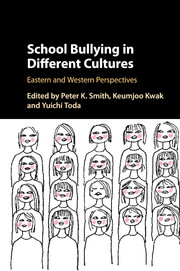Book contents
- School Bullying in Different Cultures
- School Bullying in Different Cultures
- Copyright page
- Contents
- Figures
- Tables
- Contributors
- Preface
- Foreword
- Foreword
- Part I Social awareness and research on bullying and cyberbullying
- 1 Research on bullying in schools in European countries
- 2 Research on bullying in North America
- 3 Research on bullying in schools in Australasia
- 4 Bullying (Ijime) and related problems in Japan
- 5 The Korean research tradition on wang-ta
- 6 Research on school bullying in mainland China
- 7 Bullying in Hong Kong schools
- Part II Direct cross-national data comparisons
- Part III Issues in cross-national comparisons
- Part IV Practical measures to reduce bullying problems
- Part V Conclusions
- Index
- References
1 - Research on bullying in schools in European countries
from Part I - Social awareness and research on bullying and cyberbullying
Published online by Cambridge University Press: 05 April 2016
- School Bullying in Different Cultures
- School Bullying in Different Cultures
- Copyright page
- Contents
- Figures
- Tables
- Contributors
- Preface
- Foreword
- Foreword
- Part I Social awareness and research on bullying and cyberbullying
- 1 Research on bullying in schools in European countries
- 2 Research on bullying in North America
- 3 Research on bullying in schools in Australasia
- 4 Bullying (Ijime) and related problems in Japan
- 5 The Korean research tradition on wang-ta
- 6 Research on school bullying in mainland China
- 7 Bullying in Hong Kong schools
- Part II Direct cross-national data comparisons
- Part III Issues in cross-national comparisons
- Part IV Practical measures to reduce bullying problems
- Part V Conclusions
- Index
- References
Summary
- Type
- Chapter
- Information
- School Bullying in Different CulturesEastern and Western Perspectives, pp. 3 - 29Publisher: Cambridge University PressPrint publication year: 2016
References
- 4
- Cited by

